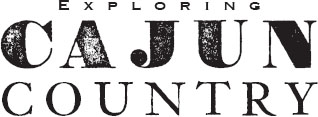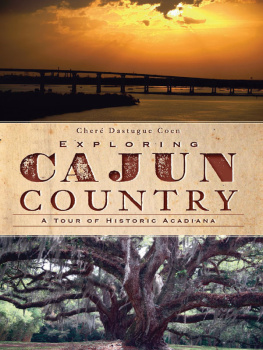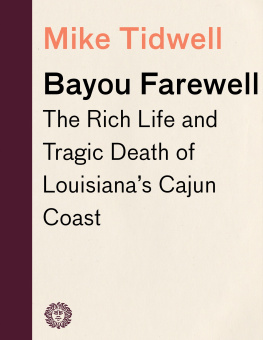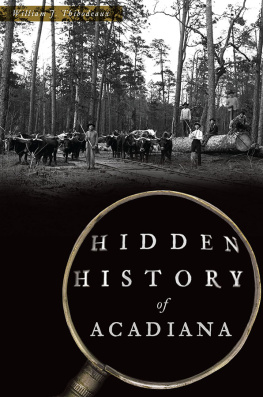

Published by The History Press
Charleston, SC 29403
www.historypress.net
Copyright 2011 by Cher Dastugue Coen
All rights reserved
Cover photos by Cher Dastugue Coen.
All internal photos are by Cher Dastugue Coen unless otherwise noted.
First published 2011
e-book edition 2013
Manufactured in the United States
ISBN 978.1.62584.150.6
Coen, Chere Dastugue.
Exploring Cajun Country : a tour of historic Acadiana / Chere Dastugue Coen.
p. cm.
Includes bibliographical references.
print edition ISBN 978-1-59629-995-5
1. Cajuns--Louisiana--Social life and customs. 2. Louisiana--Social life and customs. 3. Historic sites--Louisiana. 4. Louisiana--History, Local. 5. Louisiana--Guidebooks. I. Title.
F380.A2C64 2011
976.3--dc22
2011009605
Notice: The information in this book is true and complete to the best of our knowledge. It is offered without guarantee on the part of the author or The History Press. The author and The History Press disclaim all liability in connection with the use of this book.
All rights reserved. No part of this book may be reproduced or transmitted in any form whatsoever without prior written permission from the publisher except in the case of brief quotations embodied in critical articles and reviews.
Contents
Introduction
In 1604, a group of eager French citizens left their homeland for the shores of the New World, hoping to carve a new life from the vast wilderness. These hardworking farmers reached what is now the Maritime Provinces of Canada three years before Jamestown, four years before the settling of Quebec and fifteen years before the Pilgrims reached New England on the Mayflower.
Over time, more settlers arrived, building dykes to hold back the massive Bay of Fundy tides, an action that resulted in excellent farmland. Towns sprung up, forts were established and church parishes were created. The French pioneers called their new home Acadie, or Acadia.
Because of their isolation in the Canadian Maritimes and routine neglect from France, these hardy soles forged their way through the wilderness, connecting with neighboring Micmac Native Americans and developing a distinct identity. They became known as Acadians.
As in Europe, there were constant wars between France and England in the New World, and the rich land that the Acadians reclaimed from the Bay of Fundy passed back and forth between the two nations as England and France took control of these North America territories. In the eighteenth century, England fully conquered the area. For the most part, the British allowed the Acadians to remain on their farms, and in doing so, the French-speaking Catholic residents prospered in these fertile lands.
In 1755, a shift in government occurred, and through a series of devastating actions the Acadians were collected, their homes and belongings were seized and burned and they were shipped to the thirteen English colonies and the Caribbean, among other points south. Some ended up in English prisons, later to be repatriated back to France. Almost half of the deported Acadians died from disease and exposure aboard the ships during le grand drangement, the name given to this hideous expulsion, one of the most egregious events in North American history. Many more died in poverty in exile.
At the time, Louisiana experienced its own power shift. When the Seven Years War between France and England concluded, France had lost Canada and Louisiana east of the Mississippi (except for the island of Orleans, or New Orleans). Spain, due to its family pact with France, lost Florida to the English. In a gesture of goodwill to its partner nationalthough some may claim that France was happy to be rid of the troublesome colonyFrance ceded Louisiana to Spain in 1762.
Spain acquiring Louisiana actually made good sense, since Spain occupied the territories west of the Louisiana colony, a vast land that we now call Texas. And although the transfer of power was anything but pleasant for the French Louisiana citizens, Spanish rule lasted for thirty-four years, a time of remarkable growth and prosperity for Louisiana.
One aspect of the Louisiana colony did not change, however, and that was the fear of the English conquering the territory. England now controlled the land east of the Mississippi River, which included Baton Rouge, and Spain feared that they could easily take over New Orleans. Colonists loyal to France and Spain, notably Catholics, were encouraged to settle in Louisiana, helping to swell the ranks of local militias. Canary Islanders, for instance, were given land and equipment to farm lands near English forts along the Mississippi River, providing outposts in case of English attack.
Likewise, Acadians in exile were enticed to travel to Louisiana to start anew. Upon arrival, the Spanish government awarded them land grants, equipment and seed to start a new life. In waves, about one thousand displaced Acadians first arrived, settling in various locations throughout south Louisiana between 1757 and 1770. They arrived from the English colonies, Saint-Domingue (a French colony now called Haiti) and France. Some took farmland upriver above New Orleans, others traveled west to the Opelousas and Attakapas posts. The largest grouptotaling 1,596 peoplearrived between mid-May and mid-October 1785, settling in the southwestern region of Louisiana around todays Lafayette, Breaux Bridge and St. Martinville.
Today, descendants of these original Acadian pioneers to the Bayou State number close to a million. An equal number of Acadian descendantsthose who resisted capture or who were allowed back in restricted areastoday live in the Maritime Provinces of Canada.

Acadiana Map. Illustration by Sharon Bruno.
In Louisiana, Acadians are labeled Cajuns, an English corruption of their nickname Cadjin (pronounced Cod-gen). After the Louisiana Purchase in 1803, when Americans began migrating in great numbers to Louisiana, they heard this nickname and called the French-speaking residents Cajuns.
The area known as Cajun Country in Louisiana includes all of south Louisiana, stretching up like a triangle to the middle of the state and reaching from the Mississippi state line to the Texas border. Locals call this the French Triangle, an area rich in Acadian culture, great food, unique traditions and celebrations and people who work hard but at the end of the day like to pass a good time. In 1971, the Louisiana legislature deemed this vast region Acadiana, although most Louisiana residents refer to only the southwestern area around Lafayette as Acadiana. Regardless, this heartland of displaced Acadians now called Cajuns includes twenty-two south Louisiana parishes: Acadia, Ascension, Assumption, Avoyelles, Calcasieu, Cameron, Evangeline, Iberia, Iberville, Jefferson Davis, Lafayette, Lafourche, Pointe Coupe, St. Charles, St. James, St. John the Baptist, St. Landry, St. Mary, St. Martin, Terrebonne, Vermilion and West Baton Rouge. For the purposes of this guide, I have divided Cajun Country/Acadiana into regions/chapters: the Acadian Coast, the Wetlands of Bayou Lafourche and Terrebonne Parish, the Bayou region, Upper Prairie, Lafayette, Lower Prairie, southwest Louisiana and the Louisiana coast.

Next page













